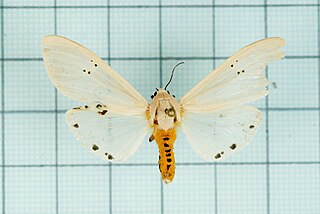
Aglaomorpha fortunei, commonly known as gu-sui-bu, is a species of basket fern of the family Polypodiaceae. The plant is native to Eastern Asia, including eastern China.

Actias sinensis, the Golden moon moth, is a moth of the Family Saturniidae. It is found in China, Taiwan, Vietnam, Myanmar, India and Thailand. The species was first described by Francis Walker in 1855.

The Callimorphina are a subtribe of woolly bear moths in the family Erebidae. The subtribe was described by Francis Walker in 1865. Many of these moths are easily confused with butterflies, being quite brightly colored and somewhat diurnal. Their antennae are not thickened into "clubs", which is a typical characteristic of butterflies.

Aglaomorpha is a genus of tiger moths in the family Erebidae.
Apisa is a genus of moths in the family Erebidae.
Nikaea is a genus of tiger moths in the family Erebidae.

East Asia is a region of Asia, which is defined in both geographical and ethno-cultural terms. The modern states of East Asia include China, Japan, Mongolia, North Korea, South Korea, and Taiwan. Hong Kong and Macau, two coastal cities located in the south of China, are autonomous regions under Chinese sovereignty. The economies of Japan, South Korea, China, Taiwan, Hong Kong, and Macau are some of the world's largest and most prosperous economies. East Asia borders Siberia and the Russian Far East to the north, Southeast Asia to the south, South Asia to the southwest, and Central Asia to the west. To the east is the Pacific Ocean and to the southeast is Micronesia.
Rivula curvifera is a moth of the family Erebidae first described by Francis Walker in 1862. It is found in Australia, China, Japan, Taiwan and on the Korean Peninsula.

Monema flavescens is a moth of the family Limacodidae. It is found in Japan, Korea, the Russian Far East, China, Taiwan, Philippines and Hyderabad (India).

Rehimena surusalis is a species of moth of the family Crambidae described by Francis Walker in 1859. It is known from Australia, China, the Andaman Islands, Sri Lanka, Indonesia, Taiwan, Korea and Japan.

Lymantria concolor is a moth of the family Erebidae first described by Francis Walker in 1855. It is found in Sikkim, the Himalayas, Taiwan and Thailand.

Creatonotos transiens is a species of moth in the family Erebidae. The species was first scientifically described by Francis Walker in 1855.

Bostra indicator is a species of snout moth in the genus Bostra. It was described by Francis Walker in 1864. It is found in China, Korea, Japan, Taiwan, Indonesia, Malaysia and India.

Cyana hamata is a moth of the family Erebidae first described by Francis Walker in 1854. It is found in Japan, China, Taiwan, Korea and Thailand.

Fascellina chromataria is a moth in the family Geometridae described by Francis Walker in 1860. It is found in Korea, Japan, Taiwan, China, India, Bhutan and Sri Lanka.
Monema is a genus of moths of the family Limacodidae.

Aglaomorpha plagiata is a moth of the family Erebidae. It was described by Francis Walker in 1855. It is found in China (Yunnan), India, Nepal, Bangladesh and Myanmar.

Spilarctia subcarnea is a moth in the family Erebidae. It was described by Francis Walker in 1855. It is found in Nepal, China, the Russian Far East, Korea, Japan and Taiwan.
Ramesa tosta is a moth of the family Notodontidae first described by Francis Walker in 1855. It is found in Sri Lanka, India, Myanmar, Java, South China, Taiwan and Japan.

Parasa bicolor, the green rice moth, is a moth of the family Limacodidae. The species was first described by Francis Walker in 1855. It is found in Sri Lanka, India, Nepal, Pakistan, Myanmar, Laos, Taiwan, Vietnam, Malaysia, Java, China and Taiwan.
















